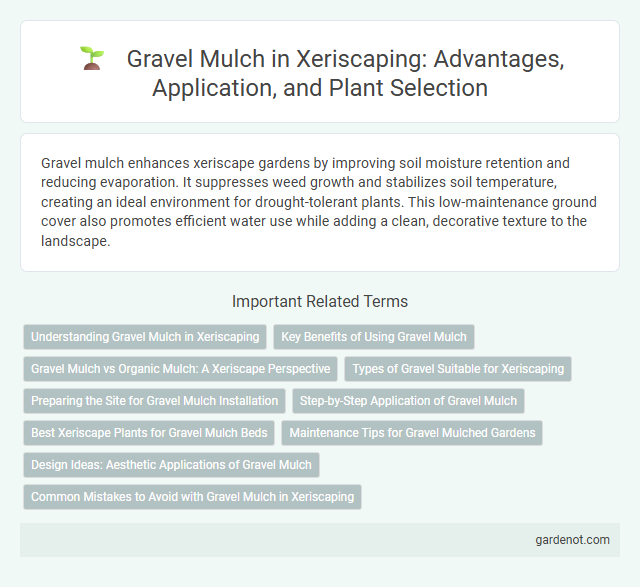Gravel mulch enhances xeriscape gardens by improving soil moisture retention and reducing evaporation. It suppresses weed growth and stabilizes soil temperature, creating an ideal environment for drought-tolerant plants. This low-maintenance ground cover also promotes efficient water use while adding a clean, decorative texture to the landscape.
Understanding Gravel Mulch in Xeriscaping
Gravel mulch in xeriscaping serves as an effective soil moisture retention method while reducing erosion and suppressing weed growth. Its porous nature allows water to penetrate efficiently, promoting healthy root systems in drought-tolerant plants such as succulents and native grasses. By reflecting sunlight and moderating soil temperature, gravel mulch helps create a sustainable, low-maintenance landscape adaptable to arid environments.
Key Benefits of Using Gravel Mulch
Gravel mulch conserves soil moisture by reducing evaporation, making it ideal for xeriscape gardens in arid climates. It prevents weed growth and enhances soil temperature regulation, promoting healthier plant roots without excessive watering. Additionally, gravel mulch provides excellent erosion control and improves landscape aesthetics with low maintenance requirements.
Gravel Mulch vs Organic Mulch: A Xeriscape Perspective
Gravel mulch offers superior water conservation benefits compared to organic mulch by reducing evaporation and improving soil drainage in xeriscape gardens. Unlike organic mulch, which decomposes and requires frequent replacement, gravel mulch provides a long-lasting, low-maintenance solution that also suppresses weed growth effectively. Selecting gravel mulch enhances drought resistance and promotes healthier plant roots, making it an ideal choice for sustainable landscaping in arid regions.
Types of Gravel Suitable for Xeriscaping
Gravel mulch in xeriscaping typically includes decomposed granite, pea gravel, and crushed stone, each offering unique benefits for water conservation and soil protection. Decomposed granite provides excellent drainage and compacts well to create a stable surface, while pea gravel is decorative and allows for efficient water infiltration. Crushed stone, available in various sizes, improves soil aeration and reduces evaporation, making it ideal for drought-tolerant landscapes.
Preparing the Site for Gravel Mulch Installation
Clear the planting area of weeds and debris to ensure proper gravel mulch installation in a xeriscape garden. Level the soil and apply a layer of landscape fabric to prevent weed growth and improve drainage. Secure edges with edging materials to keep gravel contained and maintain a clean, drought-tolerant xeriscape design.
Step-by-Step Application of Gravel Mulch
Begin by clearing the soil surface of debris and weeds to create a smooth base for the gravel mulch. Next, lay down a high-quality landscape fabric to prevent weed growth while allowing water penetration. Finally, evenly spread a 2-3 inch layer of angular gravel, ensuring proper depth for moisture retention and aesthetic appeal in xeriscape gardens.
Best Xeriscape Plants for Gravel Mulch Beds
Gravel mulch beds complement drought-tolerant xeriscape plants like lavender, sedum, and agave, which thrive in well-drained soil and require minimal watering. Plants such as ornamental grasses, yucca, and ice plant enhance both aesthetics and water efficiency, minimizing evaporation around roots. Incorporating native species like California poppy or desert marigold further optimizes water conservation and sustainability in gravel mulch landscapes.
Maintenance Tips for Gravel Mulched Gardens
Gravel mulch in xeriscape gardens requires minimal maintenance but benefits from periodic weeding to prevent invasive plants from rooting. Regularly raking the gravel helps maintain an even layer, improving soil aeration and water infiltration. Inspecting gravel for compacted areas and replenishing it every few years ensures optimal drainage and aesthetic appeal.
Design Ideas: Aesthetic Applications of Gravel Mulch
Gravel mulch enhances xeriscape design by offering a clean, modern aesthetic that complements drought-tolerant plants and natural stone features. It provides texture contrast and visual interest through varying sizes, colors, and shapes of gravel, creating defined pathways and borders that reduce water evaporation. The strategic placement of gravel mulch also improves soil moisture retention while minimizing weed growth, making it both a practical and decorative element in sustainable landscaping.
Common Mistakes to Avoid with Gravel Mulch in Xeriscaping
Using gravel mulch in xeriscaping requires careful attention to avoid common mistakes such as improper weed barrier installation, which can lead to persistent weed growth and maintenance challenges. Selecting gravel that is too small or too light can result in displacement by wind or water erosion, reducing mulch effectiveness and aesthetic appeal. Incorrect gravel depth, either too shallow or excessively thick, may impair soil moisture retention and root health, undermining xeriscape sustainability.
Gravel mulch Infographic

 gardenot.com
gardenot.com